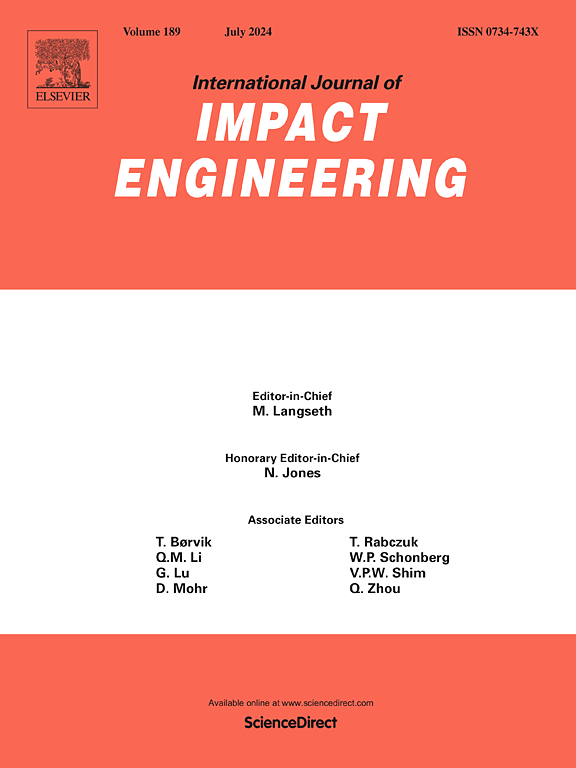Fracture mechanics of ceramic layers in composite armor: Effects of impact velocity
IF 5.1
2区 工程技术
Q1 ENGINEERING, MECHANICAL
International Journal of Impact Engineering
Pub Date : 2024-12-26
DOI:10.1016/j.ijimpeng.2024.105211
引用次数: 0
Abstract
This paper presents an analysis of the dynamic impact behavior and fracture mechanics of ceramic/metal composite armor under ballistic penetration. Utilizing 12.7 mm armor-piercing incendiary rounds for experimental testing and reinforced by numerical simulations, the study examines how varying impact velocities affect the damage patterns in the ceramic layer of the armor. A simplified model of the ceramic damage was created to interpret the fracture patterns observed. It distinguishes between two main zones of damage: the Mescall zone, which contains finer ceramic dust and takes the shape of a truncated cone along the penetration path, and the Macro-cracked zone, characterized by larger, wedge-shaped fragments. The intersection of these zones, known as the hackle zone, defines the different angular geometries of the ceramic damage. The research reveals that the Mescall zone undergoes a rise in stress from compression to a combined tensile-compressive state after the initial shockwave. In contrast, the Macro-cracked zone is dominated by tensile failure due to the primary tensile stress from the impact. Importantly, we found that as the impact velocity increases, the base radius of the Macro-cracked zone's damage cone increases while the height at which the cone crack bifurcates decreases. The size of the Mescall zone's damage cone remains relatively unchanged regardless of the impact velocity. The insights gained from this study are critical for understanding the performance of ceramic/metal composite armor under high-speed impacts and can guide the design of more effective armor systems.
求助全文
约1分钟内获得全文
求助全文
来源期刊

International Journal of Impact Engineering
工程技术-工程:机械
CiteScore
8.70
自引率
13.70%
发文量
241
审稿时长
52 days
期刊介绍:
The International Journal of Impact Engineering, established in 1983 publishes original research findings related to the response of structures, components and materials subjected to impact, blast and high-rate loading. Areas relevant to the journal encompass the following general topics and those associated with them:
-Behaviour and failure of structures and materials under impact and blast loading
-Systems for protection and absorption of impact and blast loading
-Terminal ballistics
-Dynamic behaviour and failure of materials including plasticity and fracture
-Stress waves
-Structural crashworthiness
-High-rate mechanical and forming processes
-Impact, blast and high-rate loading/measurement techniques and their applications
 求助内容:
求助内容: 应助结果提醒方式:
应助结果提醒方式:


